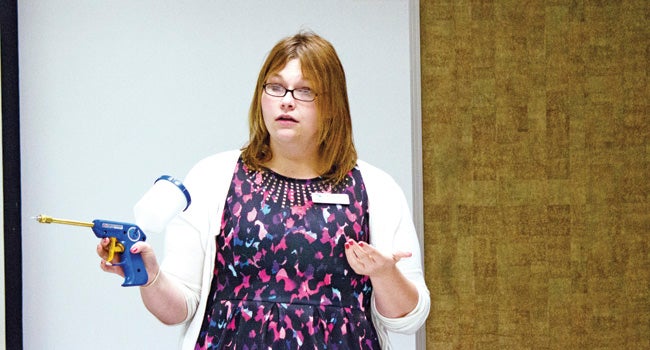County conservation district educating residents on dangers of invasive species
Published 8:00 am Friday, June 23, 2017

- Kimberly Barton, invasive species coordinator with the Cass County Conservation District, shows off a herbicide injector that residents may rent to control hostile plant species growing on their property during her presentation Wednesday at the Cass District Library. The agency is one of many combating the growth of invasive species in southwest Michigan. (Leader photo/TED YOAKUM)
While leaders in Washington continue to bat around the word “Russia” in the chambers of the nation’s capitol, officials with the Cass County Conservation District have spent the last several months dealing with the threat of foreign invaders of a different sort.
On Wednesday, one of the organization’s representatives, Kimberly Barton, briefed members of the community about the “influence” these saboteurs have on local property owners since infiltrating their way into the region: destroying local plant life, taking over lakes and damaging homes, among other sins.
Thanks to a partnership between Cass County and other regional environmental agencies, residents may get their hands on the information and tools necessary to (literally) drive these invaders off their soil.
Barton delivered a presentation about the conservation district’s recent efforts to combat the presence of invasive plant and insect species within the region at the Cass District Library Wednesday evening. The invasive species outreach educator shared information on several species residents should be on the look out for, and how to combat issues with invasive species should they encounter them on their property.
The high risk species — identified by the SW x SW Corner Cooperative Invasive Species Management Area, a group of area agencies tasked with managing the problem in Cass, Berrien and Van Buren counties — include:
• Phragmites — A tall, perennial wetland grass with distinctive, fluffy seed heads
• Japanese knotweed — A fast growing perennial with hollow, bamboo-like stems forming dense, leafy thickets
• Flowering rush — A plant that grows 1 to 4 inches along shores and shallows, with distinctive pink flowers that bloom June through August
• Black and pale swallow-wort — A vine with purplish-brown or pale, pink flowers with
milkweed-like seedpods
• European frog-bit: A floating perennial small lily pad-like plant that can from thick mats
• Chinese yam: A plant with slender vines and pointed, heart-shaped leaves with small “potatoes” that grow along the vine
• Asian long-horned beetle: A beetle whose larvae feed on most hardwood tree species, eventually killing the tree
CISMA officials placed these species on the watch list due to the damage they are capable of causing, Barton said. Several of the plants on the list have been spotted in Cass County, most prominent of which is Japanese knotweed, which has been a longstanding plague to many local farmers and property owners due to fast growing ability and how aggressively it seeks sunlight.
“It’s been seen everywhere, from Edwardsburg to Niles to Cassopolis,” Barton said. “It is not discriminatory on where it can grow.”
In addition to the detrimental effect invasive species have on native plant life and property, many species are very difficult to combat, with some having roots that spread dozens of feet underground or having specialized defense mechanisms, Barton said. While some people may think that simply mowing over the plants will deal with the issue, this proves ineffective for many species, including Japanese Knotweed, which just spreads its seeds across a wider patch.
Since joining the conservation district this past winter, Barton has traveled throughout the county, helping property owners identify and fight back against the threat of invasive species. She has also done several presentations to help spread awareness of the problem.
People who suspect they have an invasive species growing on their property should contact the conservation district, which offers its consultation services for free, Barton said. People may rent a special herbicide injector to treat plants themselves from the agency for $50, but the fee is refundable — residents must purchase their own chemicals for the treatment, however.
In order to truly manage invasive species problems, residents should work with the conservation district and other agencies to create a land management plan, which will ensure that native species are planted in place of the invasive species. This ensures that harmful plants will not re-emerge once they are removed, Barton said.
“It requires people to make a commitment to conservation and preservation of their land,” she said. “Thankfully, with so many farmers in the region, many in Cass County are committed to saving the land for generations to come.”
People who wish to contact the conservation district may do so at (269) 445-8641.






